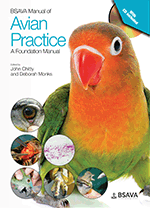
Full text loading...

Egg retention, or post-ovulatory stasis, is the failure of an egg to pass through the oviduct at a normal rate. A further and more advanced sign is dystocia. This can lead to cloacal impaction or cloacal prolapse. Causes of egg retention vary in different species and are often multifactorial. This chapter covers clinical signs, diagnostic tests, clinical approach, therapy and complications associated with egg retention. Case example: Budgerigar with distension of the caudal abdomen.
Egg retention, Page 1 of 1
< Previous page | Next page > /docserver/preview/fulltext/10.22233/9781910443323/9781910443323.25-1.gif

Full text loading...












